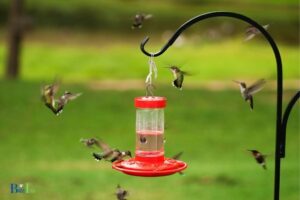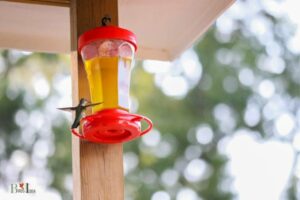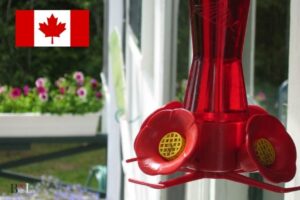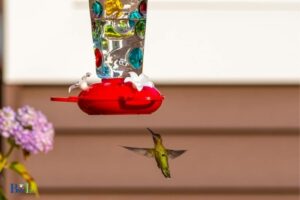How To Care For Hummingbird Feeders?
Maintain cleanliness, provide fresh nectar, choose proper feeder location, and monitor for pests.
Caring for hummingbird feeders involves proper maintenance and placement to ensure the health and safety of these delicate birds.
By following these steps, you will provide a safe and clean environment for hummingbirds to feed and thrive.
Maintaining a well-kept hummingbird feeder not only attracts more visitors but also helps to support the overall health of the bird population.
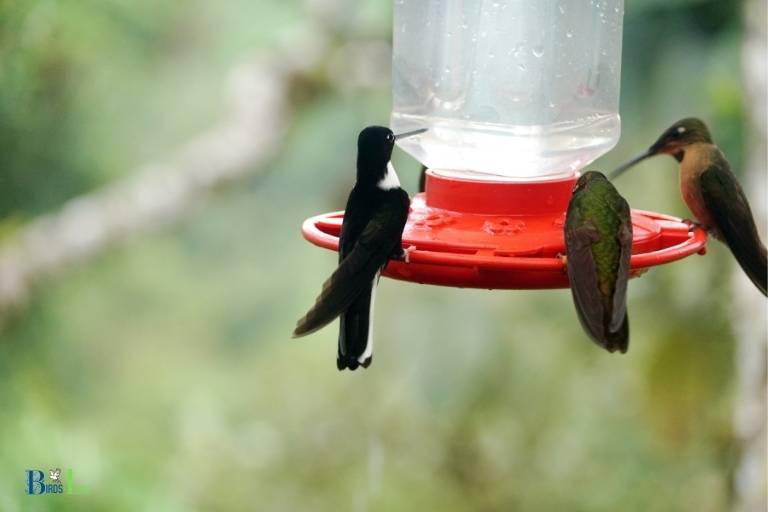
10 Steps: How To Care For Hummingbird Feeders
| Step | Description |
|---|---|
| 1 | Choose the right location |
| 2 | Select the appropriate feeder type |
| 3 | Prepare the nectar solution |
| 4 | Fill the feeder |
| 5 | Hang the feeder |
| 6 | Observe and adjust the feeder placement |
| 7 | Clean the feeder regularly |
| 8 | Replace the nectar solution frequently |
| 9 | Maintain the feeder during winter |
| 10 | Provide additional sources of food and water |
What Is a Hummingbird Feeder?
A hummingbird feeder is a specially designed container filled with nectar or sugar water that attracts and provides essential nutrition to hummingbirds.
These feeders allow bird enthusiasts and nature lovers to observe these tiny, fascinating creatures up close while also supporting their dietary needs.
Proper care for a hummingbird feeder includes regular cleaning and refilling to maintain a healthy environment for the birds.
Key points to remember:
- Choose a bright-colored feeder, as hummingbirds are attracted to bright colors, particularly red.
- Fill the feeder with a homemade nectar solution or store-bought mix, typically made of sugar and water.
- Regularly clean and refill the feeder to prevent mold and bacterial growth.
- Hang the feeder in a shaded, quiet area near flowers and plants that also attract hummingbirds.
- Be patient, as it may take some time for hummingbirds to find and become familiar with the feeder.
“Regular cleaning and maintenance of hummingbird feeders is essential for the health and well-being of these beautiful birds.”
birdsidea
What to Consider When Setting up a Hummingbird Feeder?
When setting up a hummingbird feeder, there are several factors to consider to ensure a safe and attractive environment for these tiny creatures.
Choose a feeder with bright colors, preferably red, as hummingbirds are naturally drawn to this color.
Ensure proper placement by hanging the feeder in a shady area that’s safe from predators and easily accessible for cleaning and refilling.
Use a 4:1 ratio of water to sugar for the nectar, and avoid using honey or artificial sweeteners as they can be harmful to hummingbirds. Regularly clean the feeder to prevent mold and bacteria buildup.
- Select a brightly colored feeder, ideally red
- Hang the feeder in a shady, safe, and easily accessible location
- Use a 4:1 water to sugar ratio for nectar
- Avoid honey and artificial sweeteners
- Clean the feeder regularly to prevent mold and bacteria growth
How to Clean and Maintain a Hummingbird Feeder?
To properly clean and maintain a hummingbird feeder, it is essential to ensure the feeder’s hygiene and the health of the visiting birds.
Start by emptying and disassembling the feeder, then wash each part thoroughly with a mild dish soap and warm water mixture.
Use a bottle brush to scrub away any mold or residue. Rinse the feeder components well to remove all soap traces, then let them air dry.
Refill the feeder with fresh nectar and reassemble it before hanging it back in its location. Regular maintenance, ideally every three to four days, helps avoid fermentation and mold growth.
- Empty and disassemble feeder
- Wash parts with dish soap and warm water
- Scrub residue with a bottle brush
- Rinse thoroughly
- Air dry components
- Refill with fresh nectar
- Reassemble feeder and hang in place
- Clean every three to four days for optimal hygiene
What Types of Food to Put in a Hummingbird Feeder?
Hummingbird feeders should be filled with appropriate food that provides essential nutrients for the birds.
The best option is a homemade sugar solution, mimicking the nectar found in flowers. Avoid using commercial nectar mixes, honey, or artificial sweeteners, as these can be harmful to hummingbirds.
- Use a 4:1 ratio of water to white granulated sugar for the nectar
- Boil the water, dissolve the sugar, and let the solution cool before filling the feeder
- Replace the nectar every 2-4 days, or more frequently in hot temperatures
- Clean the feeder thoroughly with hot water and a mild detergent to prevent mold and bacterial growth
Planting flowers rich in nectar, such as trumpet vines and fuchsias, close to the feeder can also attract hummingbirds and provide additional food sources.
How to Hang a Hummingbird Feeder?
To hang a hummingbird feeder, choose a suitable location that provides easy access for the birds and convenient maintenance for you. It should be visible, safe from predators, and sheltered from strong winds.
Follow these steps to ensure a proper setup:
- Select a feeder with a wide mouth for easy cleaning and refilling.
- Fill the feeder with a nectar solution (1 part sugar to 4 parts water).
- Choose a sturdy branch or hook to hang the feeder.
- Hang the feeder at least 5 feet above the ground to prevent predators from reaching it.
- Make sure the feeder is hanging securely and level.
- Clean the feeder and replace the nectar every 3-5 days to prevent mold and bacteria growth.
To attract more hummingbirds, include native, nectar-producing plants around your feeder, as these will provide an additional natural food source for the birds.
Tips for Attracting Hummingbirds to Your Feeder
Attracting hummingbirds to your feeder can be a rewarding experience, as these tiny creatures provide beauty and enjoyment to any garden.
To successfully attract hummingbirds, consider the following tips:
- Select a brightly colored feeder, preferably red, which is highly attractive to hummingbirds.
- Fill the feeder with a homemade nectar solution consisting of 4 parts water to 1 part white sugar. Avoid using honey, artificial sweeteners, or red dye, as these can be harmful to the birds.
- Hang the feeder in a sheltered location that is highly visible to the birds, near nectar-rich flowers or shrubs.
- Maintain a clean and full feeder, changing the nectar every 3-4 days or more frequently during hot weather to prevent fermentation.
- Provide a nearby water source, such as a misting system or shallow birdbath, as hummingbirds need water for drinking and bathing.
- Plant hummingbird-friendly, tubular flowers, such as trumpet vine, salvia,
Conclusion
In conclusion, caring for hummingbird feeders requires proper attention and maintenance.
Setting up the feeder correctly, cleaning it regularly, filling it with appropriate food, and hanging it in the right place are essential to attract and keep hummingbirds coming back to your garden.
By following these tips, you can provide a safe and healthy environment for these beautiful birds to enjoy.
Remember to keep your feeder clean and filled with fresh nectar to ensure the hummingbirds stay healthy and happy.
With a little effort, you can create a beautiful and inviting haven for these magnificent creatures in your own backyard.
TL;DR:
- Proper setup, cleaning, and maintenance are important for hummingbird feeders.
- Use appropriate food and hang the feeder in the right place to attract hummingbirds.
- Keep the feeder clean and filled with fresh nectar to ensure the hummingbirds stay healthy and happy.
Hummingbird Feeders and Maintenance
According to, Dirty feeders can lead to the growth of harmful bacteria and mold, which can be detrimental to hummingbirds’ health.
birdsidea
FAQ for Care For Hummingbird Feeders
What should I clean my hummingbird feeder with?
How often should I replace the nectar in my hummingbird feeder?
Is it safe to put food coloring in my hummingbird feeder?
Should I put ant guards on my hummingbird feeder?
How do you keep hummingbird feeders?
Hummingbirds are delightful creatures that are a joy to watch. To keep them coming back to your yard, it is important to keep your hummingbird feeders clean and well-maintained.
Here are some tips on how to keep your hummingbird feeders:
- Clean your hummingbird feeder with hot soapy water every 3-4 days
- Rinse your feeder thoroughly and refill with fresh nectar
- Avoid using any cleaning chemicals on your feeder as they could be harmful to the birds
- If you notice any mold in your feeder, soak it in a solution of one part vinegar to four parts water for an hour before cleaning it thoroughly again
By following these simple steps, you can ensure that your hummingbird feeders are a safe and welcoming spot for these beautiful birds to visit.
What is the best food for hummingbird feeders?
Hummingbirds thrive on nectar and insects for their protein intake, and for a good reason: nectar provides them with energy that they need for their high metabolism.
Since a hummingbird feeder consists of sugar water, it provides the necessary energy for these tiny birds.
The best food for hummingbird feeders, without doubt, is a mixture of four parts of water to one part of table sugar. Any additional coloring, flavoring, or protein supplement could be harmful to these delicate birds and should be avoided.
To keep hummingbirds healthy, ensure the water is fresh and changed often, especially during hot weather. Additionally, clean the feeder once a week to discourage the growth of harmful bacteria and fungus.
Is organic sugar OK for hummingbirds?
Hummingbirds need nectar as their primary source of energy, which they extract from flowers. Since their natural habitat is being destroyed by humans, many bird enthusiasts like to set up feeders that use a sugary solution to mimic nectar.
The question then arises: is organic sugar ok for hummingbirds? The answer is: yes! In fact, it’s even better for them.
Here are some reasons why:
- Organic sugar is free from pesticides and other chemicals that can harm the birds.
- It contains more nutrients like iron and calcium than regular white sugar, which is beneficial for their health.
- The taste is more similar to natural nectar, making it a more appealing option for the birds.
Pro Tips for Making Hummingbird Nectar with Organic Sugar:
- Use a ratio of 1 part organic sugar to 4 parts water.
- Boil the mixture for a few minutes to kill any bacteria, then let it cool down completely before filling the feeder.
- Do not add any red food coloring or other additives as they can be harmful to hummingbirds.
- Change the nectar every 2-3 days to prevent fermentation and mold growth.
Is too much sugar bad for hummingbirds?
Hummingbirds are known for their love of sweet nectar, however, too much sugar can be harmful to their health.
Here are some reasons why too much sugar is bad for hummingbirds:
- High sugar content in the nectar can cause dehydration as it can reduce the birds’ desire to consume water.
- Excessive sugar in the diet can also lead to obesity in hummingbirds, which can cause health issues.
- Too much sugar consumption can also affect the digestive system of hummingbirds, leading to fermentation and other related issues.
To avoid harming hummingbirds, it’s recommended to keep their nectar at a ratio of four parts water to one part sugar.
Additionally, it’s important to regularly clean hummingbird feeders to prevent mold and bacteria growth, as these can also be harmful to the birds.
How much sugar does a hummingbird consume?
Hummingbirds consume a significant amount of sugar daily, which provides them with the energy they need to fly and hover continuously. However, it’s essential to feed them the right amount of sugar to maintain their health.
Here are a few things to keep in mind when feeding hummingbirds:
- The recommended sugar-water solution is four parts water to one part white granulated sugar.
- Avoid using honey, brown sugar, or artificial sweeteners, as they can be harmful to hummingbirds.
- Change the nectar every three to five days to prevent fermentation and the growth of harmful bacteria.
- Clean the feeder with hot water and soap between each refill to prevent the spread of disease.
- Use red-colored feeders or add a red ribbon or flower nearby to attract the hummingbirds’ attention.
Is coconut sugar safe for hummingbirds?
As a hummingbird lover, it’s important to provide them with a safe and healthy diet. Many people leave feeders filled with sweetened water to attract hummingbirds.
However, not all sweeteners are safe for them to consume. Coconut sugar is a popular alternative to traditional table sugar, but is it safe for hummingbirds?
While there is no clear answer, it’s best to err on the side of caution and avoid offering coconut sugar to these delicate birds.
Here are some tips for safely caring for your hummingbird feeders:
- Always use plain white granulated sugar to make hummingbird nectar
- Change nectar every 3-5 days and clean feeder with hot water and soap monthly
- Use a 4:1 ratio of water to sugar for nectar
- Do not add honey, brown sugar, or artificial sweeteners to the nectar
- Place feeders in a shaded area to prevent spoilage and fermentation
- Avoid using red dye in nectar as it can be harmful to hummingbirds’ health. Use red-colored feeders instead.
How do you keep hummingbird feeders?
Hummingbirds are delightful creatures that are a joy to watch. To keep them coming back to your yard, it is important to keep your hummingbird feeders clean and well-maintained.
Here are some tips on how to keep your hummingbird feeders:
- Clean your hummingbird feeder with hot soapy water every 3-4 days
- Rinse your feeder thoroughly and refill with fresh nectar
- Avoid using any cleaning chemicals on your feeder as they could be harmful to the birds
- If you notice any mold in your feeder, soak it in a solution of one part vinegar to four parts water for an hour before cleaning it thoroughly again
By following these simple steps, you can ensure that your hummingbird feeders are a safe and welcoming spot for these beautiful birds to visit.



